Dozens of satellites are busy day and night, beaming your favorite TV and radio programs from more than 35,000 kilometers away. Here's how to tune into them.

Wikimedia Commons / PD
Last week, I pointed my camera at a random spot in Aquarius along the the geosynchronous satellite belt, made a 3-minute exposure at f/2.8 and ISO 400, and then pressed the back screen button to check for anything interesting. Wow, wow, wow. There they were — not one, not two, but 11 pinpoint satellites in a row! I did the same a couple nights later, and although the stars had shifted to the west, the satellites stood in exactly the same place. I was hooked.
From Earth, a satellite in geosychronous orbit appears to hover over one spot of the equator, matching Earth's rotation rate. To a ground observer, they appear almost motionless, but they're zipping along at 11,300 kph (7,000 mph) to keep up with Earth's spin. As of August 10, 2017, there were 447 active geosynchronous satellites in a ring around the planet with space remaining for about 1,400 more.
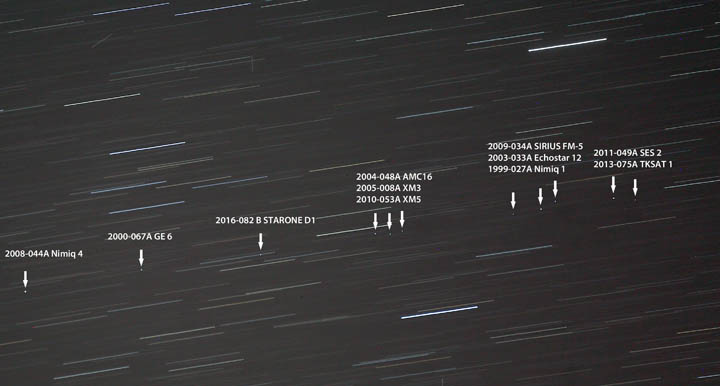
Bob King
Each satellite occupies a orbital slot far enough away from the others to avoid communication interference or a potential collision. Geostationary satellites remain exactly at one spot above the equator, with their positions maintained by thruster burns. Geosynchronous satellites' orbits are slightly inclined and describe a north-south-inclined figure-8 or analemma during the course of the day. Anomalies in Earth's gravitational field combined with the tug of the Moon cause all geosats to drift unless repositioned by thrusters. Satellite controllers make sure that any drift doesn't extend outside the bounds of the predetermined "box" within a slot.
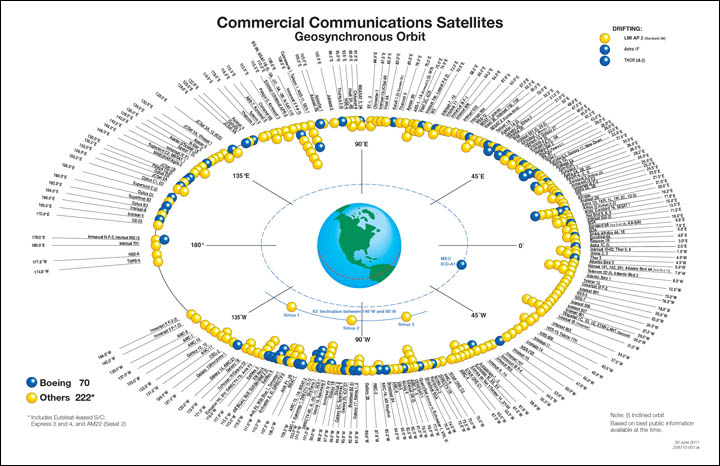
Boeing
Most geosats are used for communications. A dish on the ground can grab a TV transmission by simply locking onto a geosat instead of having to track a satellite across the sky. Thanks to these distant birds, our favorite TV shows and other communications can be transmitted around the planet. Geosynchronous orbit also makes a perfect haunt for spy satellites. The military can park over the point of interest and monitor transmissions 24 hours a day as well as track enemy missiles. The nightly weather photos, the same we check on our mobile phones when planning an observing session, are sent every 15 minutes by the geostationary satellites, GOES-East and GOES-West, positioned at 75° west and 135° west longitude respectively. Together, they provide complete views of both hemispheres of Earth.
Many geosynchronous satellites shine between magnitudes 10–12, so you can spot them in telescopes as small as 4 inches. They're also easy to photograph. High ISOs and fast, low light lenses aren't necessary, just a camera capable of a several-minute-long time exposure — long enough for the stars to trail, so you can easily tell them apart from the satellites. Set your shutter speed to "B" and ISO at 400. You can hold the shutter button down with your finger, but a shutter release cable is much better and vibration-free. Use a 100–200-mm telephoto lens, focus sharply, and expose for 2–4 minutes. When you enlarge the image, you'll should see long trails and a line of pinpoint dots — satellites!
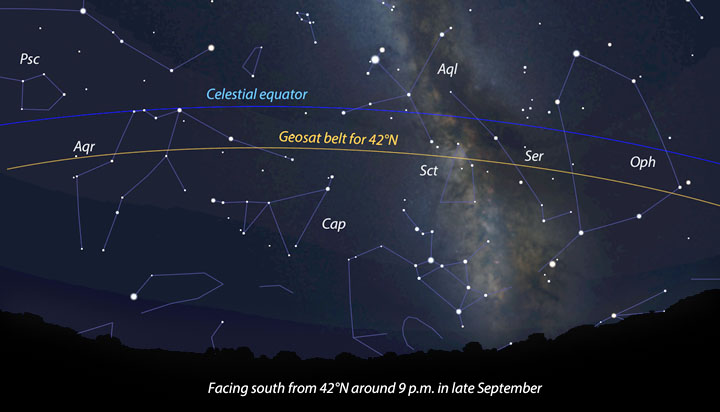
Stellarium
Of course, you'll need to know the location of the geosat belt from your latitude. Northern hemisphere skywatchers see the belt several degrees south of the celestial equator because of parallax. For instance, from my latitude of 47°N, the belt arcs across the southern sky at declination –7°, or about 36° high at the meridian. The table below will help you know where to look for your latitude; reverse the sign if you're observing from the southern hemisphere.
| Latitude | Dec. |
| 0° | 0° |
| 10° | –1.8° |
| 20° | –3.4° |
| 30° | –5.0° |
| 40° | –6.3° |
| 50° | –7.3° |
| 60° | –8.1° |
| 70° | –8.5° |
| 80° | –8.7° |
When I'm in a geosynchronous-satellite-watching mood, I open up a sky-mapping program like Stellarium and have it draw the celestial equator. Then I click below the equator along an arc of sky at declination –7°, looking for brighter stars and easy deep-sky objects. Outside at the telescope, I center that star or object in a low magnification (64×) field of view and wait. Be sure to turn off your clock drive or tracker for the best effect. What you'll see next is one of the best illusions in the night sky.
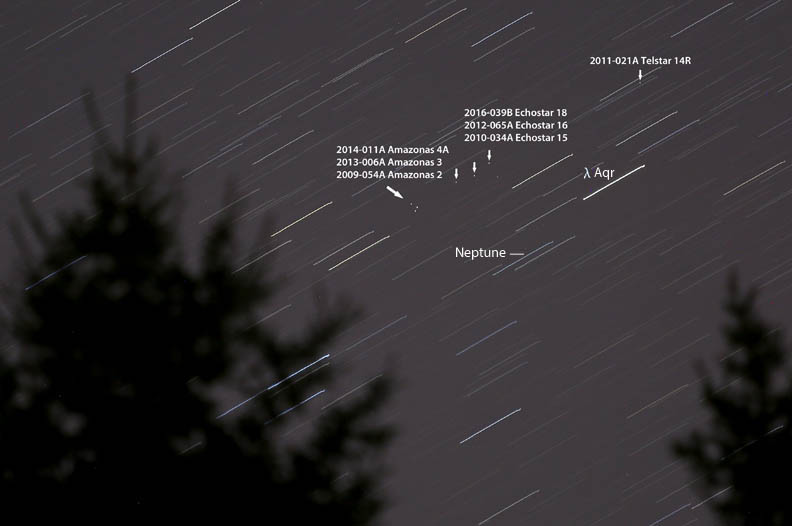
Bob King
Assuming geosats are in the field of view, they'll appear at first to drift to the east, until it dawns on you that no, the satellites are fixed and the stars are doing the moving, dragged across the field by Earth's rotation. Your instinct is to push the scope along to follow the satellites, but no need. They're not going anywhere. The other night I centered my 10-inch on a spot near Theta (θ) Aquarii and within a minute swept up four geosats between magnitude 10–11 in a compact group about 12′ across.
To identify the satellites you see or photograph, go to CalSky, let it find your location (automatic), then under the topic headings, click Satellites and then the Geostationary link. You'll be shown a list of geosats, with their magnitudes and positions (in R.A. and Dec.), that are visible from your site that night. Click the Star Chart link under the geosat's name for a map showing its position on a star map. Star names and data appear when you place your cursor over the star symbols.
To see pictures and learn more the purpose and other details of each satellite, stop by Gunter's Space Page, a fantastic resource. Hint: the search button is down to the lower left of the page.
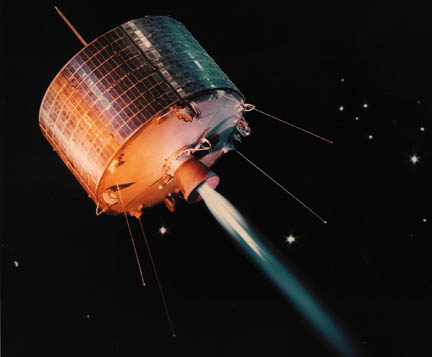
NASA
Unlike the ISS and the many objects in low Earth object, geostationary satellites are visible all night long every night of the year. They only disappear for up to 70 minutes a day when entering Earth's shadow about two weeks either side of each equinox. At that time, their orientation in relation to the Sun (which is directly at your back) favors flaring.
If you make a point to look for geosats shortly before they enter or shortly after they leave the shadow, you might catch a flare, some of which are bright enough to see in binoculars and rarely, with the naked eye.
Listen to Sirius Radio? Get your TV via satellite? It's just cool to see where it all comes from — outer space. For more on satellites, please see my companion blog on low-Earth orbiting satellites published last month.
(Note: A special thanks to satellite enthusiast Alain Figer for helping ID the satellites in the photos and to astrophotographer Thierry Legault for the geosynchronous belt declination table.)
 4
4








Comments
Tom-Reiland
September 20, 2017 at 5:00 pm
Bob, We are approaching a time of the year when Geosats can be seen naked-eye in the morning sky. I noticed this totally by accident one morning in early October around 10 years ago. The location is in the SW in an area near Theta Ceti, from what I can recall. I happened to look there that morning between 2 and 3 AM when I spotted not one, but two of them. My first reaction was, Wow, two Novae in the same area of the sky. Then I realized what I was seeing and pointed the scope towards them and shut off the drive. It could see the stars moving in the background while the Geosats didn't move. Soon after that, I observed several more with my nude eyes and also, with my 10 X50 binocs. I'm looking forward the end of September and first 8 to 10 nights of October to try to spot them again. The Sun angle must be perfect during this 10 night to two week period to allow us to see them without any optical aid. I've seen a couple in the SE in the Spring in the evening, but they don't seem to be as prominent as in the Autumn. On other occasions, I have seen naked-eye Geosats when the Sun hits them perfectly. They don't appear to be visible as long as the Autumn show, maybe a few seconds instead of minutes. The Moon might limit what we can see this year with the Full Harvest Moon on Oct 5. Good hunting to all.
You must be logged in to post a comment.
Bob KingPost Author
September 25, 2017 at 12:42 pm
That's right, Tom. I'll be watching too!
You must be logged in to post a comment.
Dungaree Dogs NYC
April 3, 2023 at 11:30 pm
I see plenty here in NYC, light and atmospheric pollution be damned. I don’t know if anyone see’s them flashing red and green as we do here. The past few nights especially.Earth’s position with relation to the Sun is really making the flashes very bright. Very cool, looks like Police cars in space.❤️
You must be logged in to post a comment.
Bob KingPost Author
April 4, 2023 at 12:41 am
Hi DD NYC,
Thank you for writing. Are you sure you're seeing geosynchronous satellites? I ask because they don't show colors and are usually only visible in a telescope. Sometimes when conditions are just right you'll get an occasional flash to naked-eye brightness.
You must be logged in to post a comment.
You must be logged in to post a comment.